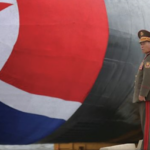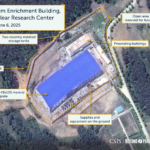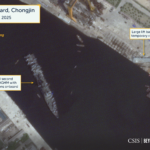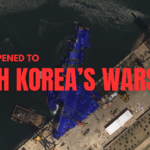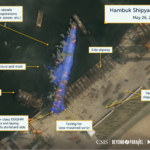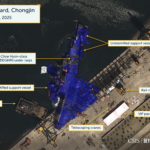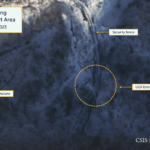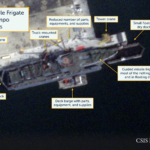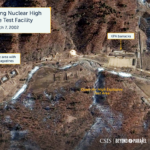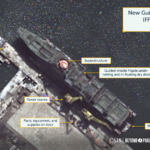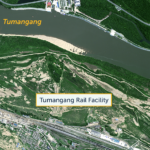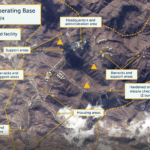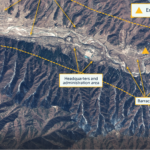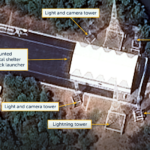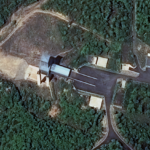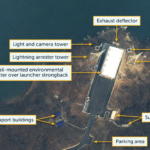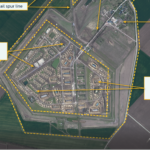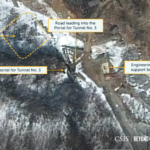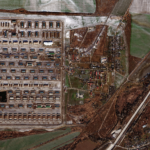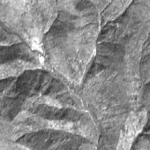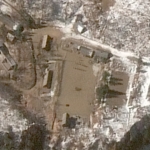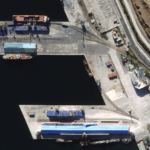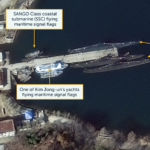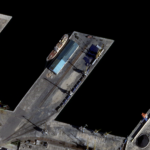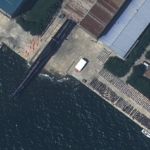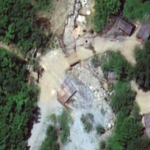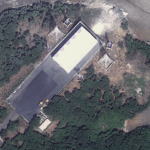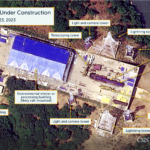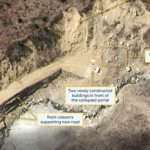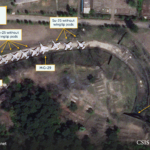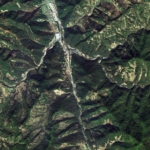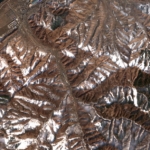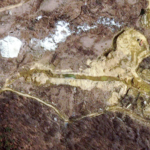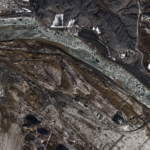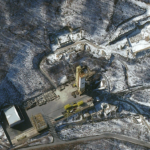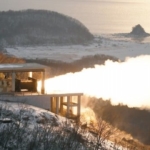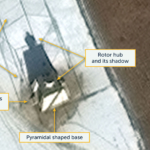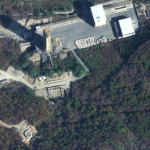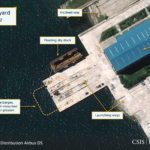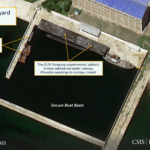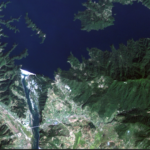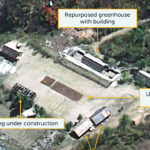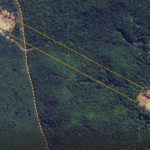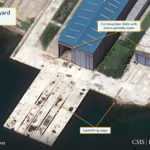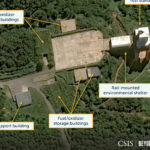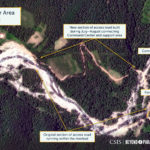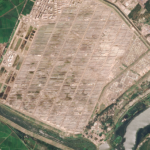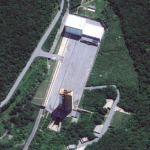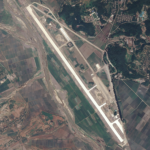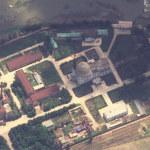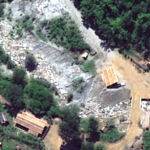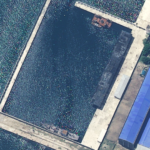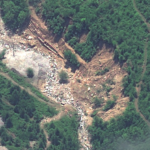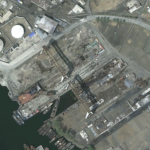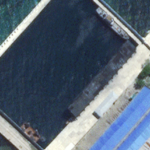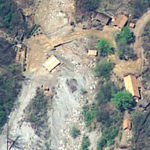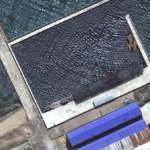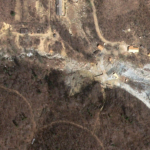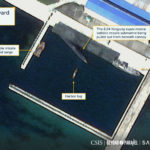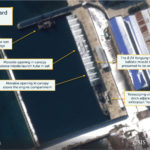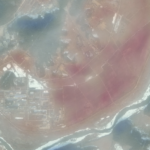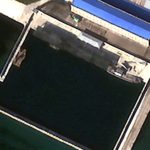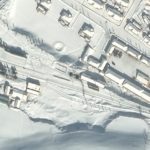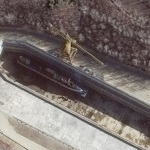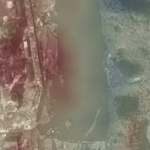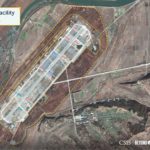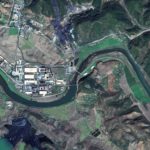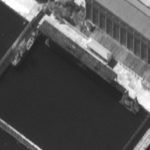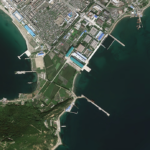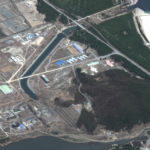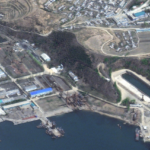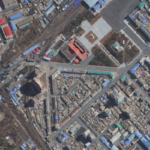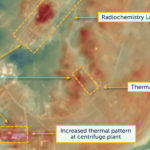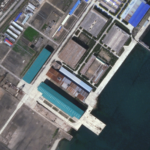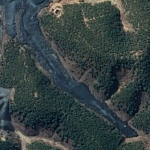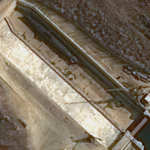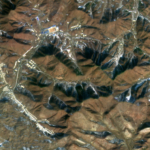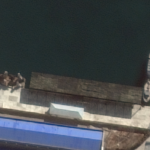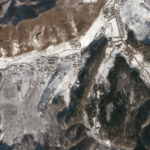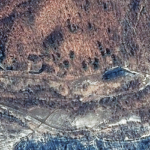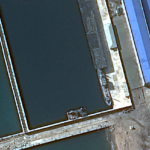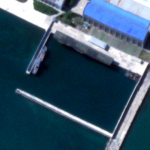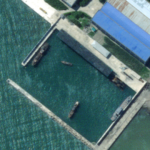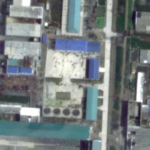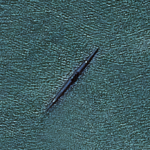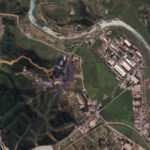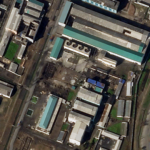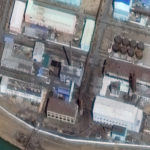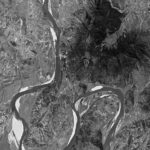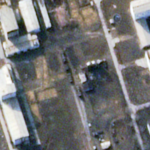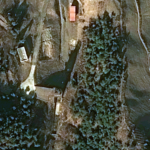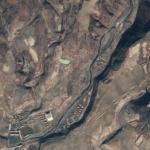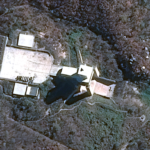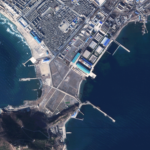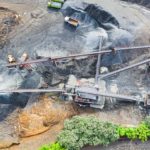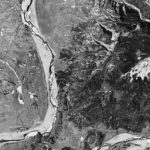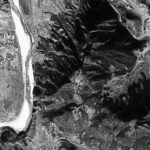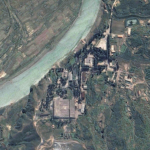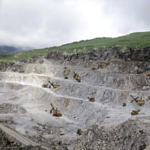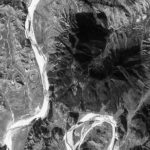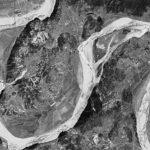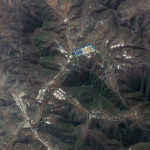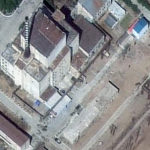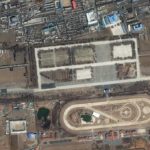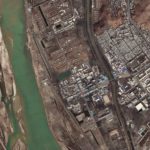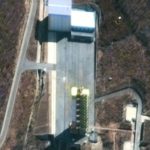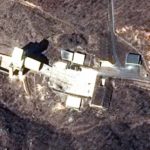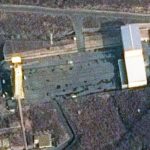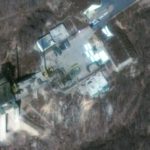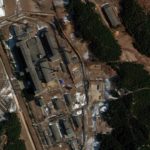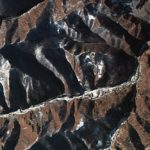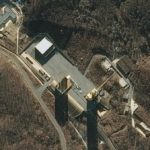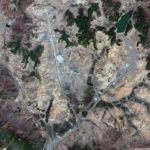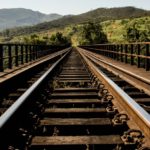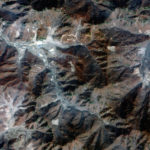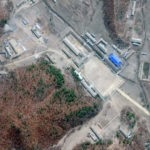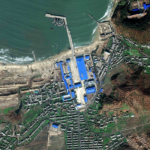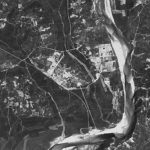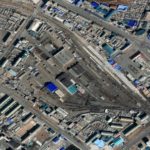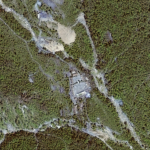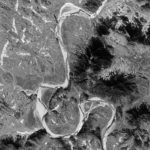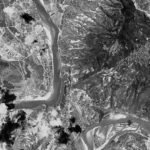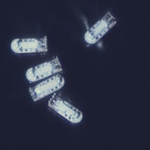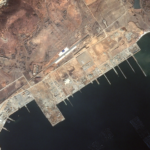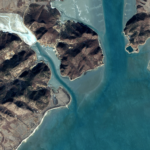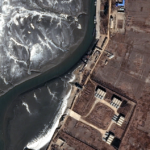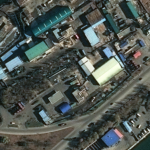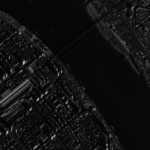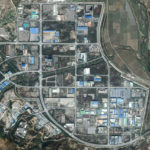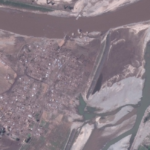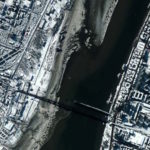FEATURED
Approximately 27 kilometers from the China-North Korean border, the Sinpung-dong Missile Operating Base is an undeclared North Korean missile base.
Satellite images show North Korea’s first true ballistic missile not yet fully operational, almost two years after its launching.
Satellite imagery and AIS data analysis provide the first comprehensive timeline on the Chinese structures in the South Korea-China Provisional Measures Zone.
This book offers the most definitive study of North Korea's ballistic missile submarine (SSB), submarine-launched ballistic missile (SLBM), and submarine-launched cruise missile (SLCM) programs.
North Korea launched its second Choe Hyon-class destroyer, named the Kang Kon, at Najin. This is the second of its largest warship class ever produced by North Korea.
Recent satellite image shows the construction of a likely new uranium enrichment plant at Yongbyon.
Recent satellite image shows the destroyer which failed launching at Chongjin has now been moved to Najin shipyard for restoration.
Latest satellite imagery shows North Korea having successfully completed the initial salvage operations on the DDGHM at Chongjin.
What happened to the failed launch and damage of North Korea's second guided missile destroyer on May 21, 2025?
Latest satellite image of Chongjin shows the ongoing salvage operation of the vessel assessed to be the second Choe Hyon-class guided missile destroyer.
Satellite imagery confirmed North Korea's reporting that a new destroyer at Chongjin has failed to launch, leading to significant damage.
Imagery shows dramatic increases in Sino-North Korean trade at the lesser-known Wonjong-ni-Quanhe border crossing over the past few years.
Recent satellite image shows that a second vessel in the Choe Hyon-class of guided missile destroyers (DDGHM) is under construction at the Hambuk Shipyard in Chongjin.
The last of a three-part series on the Yongdok-tong Nuclear High Explosive Test Facility, a critical component in the research, development, test, and evaluation (RDT&E) of North Korea’s nuclear warheads, explores the underground facilities at Yongdok-tong and elsewhere.
The second of a three-part series on the Yongdok-tong Nuclear High Explosive Test Facility, a critical component in the research, development, test, and evaluation (RDT&E) of North Korea’s nuclear warheads, explores development from 2010s to today.
On April 25, North Korea launched the guided missile destroyer (DDGHM) Choe Hyon, the largest warship ever produced by North Korea.
Recent imagery show clearest view yet of North Korea's largest warship, the new guided missile frigate (FFG), with netting removed.
The Yongdok-tong Nuclear High Explosive Test Facility is the only known operating facility in the country for testing designs and components for high-explosive detonation of nuclear weapons. This is the most comprehensive report of this secret facility currently available at the unclassified level.
The new road bridge at the Tumangang-Khasan border constitutes more evidence of the burgeoning strategic partnership between Russia and North Korea. However, Recent satellite imagery shows the construction of the road bridge has stalled.
Recent satellite images indicate that Uiju has returned to full operational status with Il-28 aircraft redeployed at the airbase previously used for rail freight quarantine facility during COVID-19.
New satellite image provides the closest look to date of the new North Korean Navy’s guided missile frigate (FFG) at the Nampo Navy Shipyard.
Latest satellite images of Panghyon Airbase, North Korea's only known site for the flight testing of large strategic UAVs, show notable ongoing development.
The ongoing high levels of rail traffic and major modernization of rail facilities at Tumangang indicates that the strategic relationship between North Korea and Russia continues to grow.
Located 242 kilometers north of the demilitarized zone and only 65 kilometers from the Chinese border, the Yongnim Missile Operating Base is an undeclared ballistic missile operating ICBM base in Chagang Province.
Satellite image of the Punggye-ri Nuclear Testing Facility acquired on October 4, 2024, a few days before the rapid escalation of tension in the peninsula, shows that the facility continues to be well maintained.
Satellite images of the NK-China border indicate that trade between the two countries is gradually recovering to pre-pandemic levels. However, this restoration of trade was upended when unusually heavy rains struck the area in late July.
Beyond Parallel reviewed satellite imagery of the Russia-North Korea border at the Tumangang-Khasan railroad crossing from early February to mid-July 2024, a few months before and a few weeks after Russian President Vladimir Putin’s visit to North Korea on June 18. The analysis between February and July 2024 shows a new railcar traffic pattern at the Russia-North Korea border.
Despite the goal of advancing denuclearization of the Korean peninsula through leader-to-leader exchanges in 2018 and 2019, thermal infrared (TIR) imagery of the Yongbyon Nuclear Research Center around the summit dates reveals limited impact on Yongbyon’s overall operational status.
This second part of the missile operating bases update covers developments at Sakkanmol, Sangnam-ni, Sino-ri, and Yusang-ni Missile Operating Bases over the past several years.
Part 3 of this series builds upon the methodology and findings presented in Part 1, offering a deeper dive into the operational nuances of the Radiochemistry Lab and the centrifuge plant.
Part 2 of this series builds upon the methodology and findings presented in Part 1, offering a deeper dive into the operational nuances of the 5MWe Reactor and the Experimental Light Water Reactor.
TIR (TIR) analysis via LANDSAT 8 and 9 imagery over two years provides key insights into Yongbyon nuclear facilities' operations, highlighting the intricate strengths and limitations of thermal imagery for operational assessment.
In an exceptional surge of activity during the past five weeks, North Korea has undertaken moves at Sinpo of the Hero Kim Kun Ok ballistic missile submarine (SSB), the 8.24 Yongung experiment ballistic missile submarine (SSBA), and the submersible missile test stand barge.
Satellite imagery shows that North Korea has undertaken numerous small and some significant changes at most of its ballistic missile operating bases over the past five years.
A recent failed launch attempt of another reconnaissance satellite by North Korea is a clear demonstration of the political importance assigned to launches by Kim Jong-un and his desire to meet the goal of launching three satellites in 2024.
Satellite imagery indicates that North Korea conducted an unannounced test of a liquid propellant rocket engine from the Yunsong vertical engine test facility during the fourth week of April 2024. Earlier in the month, several sources suggested that North Korea was preparing to conduct another satellite launch. While there were some indications that a launch attempt might occur within the month, it did not.
North Korea has reportedly been preparing to launch its second reconnaissance satellite. Recent satellite imagery suggests that a launch was planned but canceled for unknown reasons.
Recent satellite imagery reveals ongoing high-level utilization of Russia's Tikhoretsk Munitions Storage Facility, where munitions from North Korea are being stored.
Recent satellite image of the Punggye-ri Nuclear Test Facility indicates that North Korea continues to be committed to maintaining the general health of the facility.
Ammunition supplies have become critical in the Ukraine war. CSIS studied hundreds of commercially available satellite images since August 2023 on the continuing transfer of large quantities of munitions between North Korea and Russia.
The first open-source analysis of declassified satellite imagery suggests that the construction of North Korea's Punggye-ri Nuclear Testing Facility started as early as 1985 to 1986.
Satellite image of the Punggye-ri Nuclear Test Facility acquired on January 16, 2024, shows activity which indicates continued commitment for maintenance of the construction achieved in 2023.
Satellite images of Najin Port over the past two months show a high level of activity, suggesting that arms transfer between DPRK and Russia continue.
Recent satellite images of Sinpo South Shipyard and Mayang-do Submarine Base suggest preparations for an important event.
Latest satellite imagery of Najin Port indicates that at least six trips transporting munitions have been made by sea between North Korea and Russia.
A few weeks after the Kim-Putin summit, satellite imagery show an unprecedented level of rail traffic at the DPRK-Russia border.
North Korea launched a new ballistic missile submarine, the Hero Kim Kun Ok, at the Sinpo South Shipyard. Satellite imagery analysis before, during, and after the launch details the unveiled and much-anticipated submarine and changes to the nearby environment.
Recent satellite imagery of the Punggye-ri Nuclear Test Facility shows minor activity at the main administration area and no new activity at the tunnels. However, preparations at Tunnel No. 3 are considered to have long been completed.
Satellite imagery of the Sohae Satellite Launching Station taken five hours after the launch of North Korea's military reconnaissance satellite shows indications of the recent launch at the new coastal launch pad.
Latest imagery of the Sohae Satellite Launching Station show preparations underway for the launch of the country's first-ever reconnaissance satellite.
Imagery of the Sohae Satellite Launching Station shows accelerated expansion and an unusual number of construction resources allocated to the station, indicating that North Korea is moving to develop, transport, and launch larger, more sophisticated SLV/missiles.
Recent satellite imagery shows new activity at the Punggye-ri Nuclear Test Facility, including the completion of road construction and new structures by the collapsed portal of Tunnel No. 4.
Recent satellite imagery shows that the ongoing modernization project at Sunchon Airbase is nearing completion, along with the presence of ten aircraft - the first observed in two years.
Satellite imagery analysis provides an in-depth understanding of the Manpo Unha Factory, an important but previously little-known component of North Korea's nuclear infrastructure, and its historical development.
Imagery analysis has identified the Manpo Unha Factory as an important but little-known component of North Korea's nuclear infrastructure as the prime supplier of bulk chemicals to the Yongbyon Nuclear Research Center.
Ongoing development at the Sohae Satellite Launching Station seen in recent satellite imagery show continued preparations to expand the facility's capabilities to host larger rocket launches.
Analysis of recent commercially available satellite imagery of the Russia–North Korea railroad crossing suggests significantly increased energy and economic trade as Pyongyang seeks to tighten ties with Moscow.
Dramatic and ongoing construction progress continues throughout the eastern and central sections of the Sohae Satellite Launching Station, including new construction near the horizontal engine test stand.
Latest commercial satellite images of the Sohae Satellite Launching Station show construction has entered a new phase, including the addition of a new horizontal engine test stand, further expanding the facility's future capabilities.
The small object which appeared in 2019 at the southern end of North Korea's Panghyon Aircraft Factory produced various speculations by watchers. The object is identified to be a helicopter rotor blade test rig, a critical component in maintaining the KPAF helicopter force.
North Korea has shown an unprecedented level of provocations over the past week. As tensions rise, eyes are also on Punggye-ri, the expected site of the seventh nuclear test. This report provides an updated view of the facility.
Significant progress in the construction of the Sohae Satellite Launching Station is observed in recent satellite imagery as part of the dramatic and ongoing modernization plan announced by Kim Jong-un earlier this year.
For the past two months, a significant increase in activity has been observed at the Sinpo South Shipyard, suggestive of longer-term preparations for North Korea's launching of the new SSB or testing newer, more capable SLBMs.
North Korea's seventh nuclear test is assessed to be carried out in the coming weeks. This report provides an updated view of the Punggye-ri Nuclear Test Facility, where the test will almost assuredly take place.
For the past two months, a significant increase in activity has been observed at the Sinpo South Shipyard, suggestive of longer-term preparations for North Korea's launching of the new SSB or testing newer, more capable SLBMs.
North Korea’s September 25 test launch of a ballistic missile from the Taechon Reservoir was a short-range ballistic missile (SRBM), not a submarine-launched ballistic missile (SLBM) as commonly reported. The missile used for this test appears to be a modified version of the KN-23 SRBM. The original single-stage, solid propellant KN-23 was first tested in May 2019.
Recent satellite images of the Punggye-ri Nuclear Test Facility show new clearing and construction near Tunnel No. 4. As expected, no new activity was observed at Tunnel No. 3, where North Korea is assessed to have finished all preparations for a test.
Significant construction continues at the Sohae Satellite Launching Station including the expansion of fuel/oxidizer storage capacity and construction of what may be a large underground or support facility.
Recent satellite images of the Sinpo South Shipyard, a critical location in North Korea's development of SSB and SLBM capabilities, show vessel movements and new construction in the area.
Indications of an unannounced engine test, along with significant construction activity, were recently observed at the Sohae Satellite Launching Station.
Recent satellite images show efforts to mitigate flood damage at the Punggye-ri Nuclear Test Facility, where North Korea has finished all preparations for conducting a seventh nuclear test.
Built on the former grounds of Yonpo Airbase, the Yonpo Vegetable Greenhouse Farm is a top-priority project for North Korea and, once completed, will become North Korea's largest agricultural greenhouse complex.
Four months after Kim Jong-un’s March 2022 inspection of the Sohae Satellite Launching Station and the public announcement of a modernization and development project, satellite imagery shows that the first stages of construction are now actively being pursued.
Recent satellite imagery shows North Korea is making slow but steady progress with its renovation and expansion of the North Korean Air and Air Defense Force's Sunchon Airbase.
A high-resolution satellite image from July 3, 2022, shows the current observable status of the Yongbyon Nuclear Research Center, where flooding of the nearby Kuryong River and new activity is observed near Building 500—the first such activity since 2016.
Recent satellite image clearly details the current observable status of the Punggye-ri Nuclear Test Facility, where North Korea is assessed to have finished all preparations for conducting a nuclear test.
Satellite image collected on June 16 of the Sinpo South Shipyard shows that the submersible missile test stand barge has once again exchanged positions with the infiltration mothership, and various pieces of equipment are visible on the apron of the nearby pop-up test stand.
New satellite imagery of the Punggye-ri Nuclear Test Facility shows not only ongoing work at Tunnel No. 3, but also new indicators of construction activity at Tunnel No. 4 further north.
Satellite imagery collected from the last several months show intermittent activity on North Korea’s second submersible missile test stand barge located in Nampo Navy Shipyard on the west coast.
Recent satellite imagery provides the first views of the secure boat basin at Sinpo South Shipyard since the SLBM test launch on May 7. The images show the submersible missile test stand barge has exchanged positions with the infiltration mothership once again.
A high off-nadir satellite imagery collected on May 17, 2022, provides a unique view of the ongoing activity outside the new portal to Tunnel No. 3 (South Portal) and in the main administration and support area of the Punggye-ri Nuclear Test Site.
Satellite image collected on April 20 provides one of the most detailed and current views of the Sinpo Shipyard, which houses North Korea's experimental ballistic missile submarine and submersible test stand barge.
Recent satellite image shows indications of ongoing construction work near and inside Tunnel No. 3 at the Punggye-ri Nuclear Testing Site.
While minor changes have taken place at Sohae Satellite Launching Station over the years, satellite imagery and other sources indicate that the roots of the recently announced modernization and expansion program likely date back to 2019.
Recent satellite image shows unusual movement of the 8.24 Yongung experimental ballistic missile submarine (SSBA) within the secure boat basin at North Korea's Sinpo South Shipyard.
The telescoping crane that appeared in Sinpo South Shipyard's secure boat basin in early January is still present. It is unclear if the telescoping crane is an indicator of continued work on 8.24 Yongung SSBA, new work being undertaken on the infiltration mothership, an ongoing deception program, or a combination of these and other reasons.
LANDSAT 7 and LANDSAT 8 thermal infrared satellite imagery in January and February show that warm water is being discharged from the 5MWe reactor at Yongbyon, confirming that the reactor and its cooling system are in operation. Thermal patterns from the same period suggests that the IRT-DPRK reactor, the Radiochemistry Laboratory, and the centrifuge plant are occupied, but not necessarily operational, and not in a state of shutdown.
Located 338-kilometers north of the demilitarized zone and only 25-kilometers from the Chinese border in Chagang Province, the Hoejung-ni missile operating base will, according to informed sources, likely house a regiment-sized unit equipped with intercontinental ballistic missiles (ICBM).
North Korea’s SINPO-class experimental ballistic missile submarine suffered a malfunction likely resulting in damage during the October 19, 2021, SLBM test launch.
Recent thermal infrared imagery of the Yongbyon Nuclear Research Center show warm water being discharged from the cooling system of the 5MWe reactor and that the reactor is in operation. During the past several months, water discharge from the reactor and probable steam exhaust from the steam turbine and electric generator hall has been observed in visible satellite imagery. Through thermal imagery, it can be determined that the water that is being discharged is indeed warm water discharge from the reactor's cooling system.
Over 16 months after its shutdown of the border with China to prevent COVID transmission, North Korea has seen delays in its efforts to re-open commerce with its primary trade partner. The conversion of Uiju Airbase into a disinfection facility started in early 2021, but the most recent satellite imagery as of November 12 shows no signs of being operational, indicating a delay of at least six months from its original opening plans. Smaller-scale disinfection facilities at other crossings appear to be in development.
The Pyongsan Uranium Concentrate Plant remains the sole verified producer of uranium concentrate in North Korea. As such it represents the foundation upon which the nation’s production of fissile material for nuclear weapons is built. Commercial satellite imagery collected from April through October 2021 continues to demonstrate that despite the absence of any nuclear testing by North Korea since 2017 the Pyongsan Uranium Concentrate Plant remains operational, continues to be maintained, and is producing uranium concentrate (U3O8, “yellowcake”).
North Korea test-fired a “new type” of submarine-launched ballistic missile (SLBM) on October 19, 2021, from waters in the Sinpo area. The test launch of the new SLBM is one of a series of recent provocative missile tests that demonstrate advancements in the survivability of North Korea’s nuclear weapons and ballistic missile programs.
Food security is a perennial domestic concern for North Korea. This report utilizes remote sensing analysis to understand the current condition of North Korea’s food production and crop yields that the country will depend on for the coming year.
Thirteen satellite images of the Sinpo South Shipyard and its environs collected between April 21 and September 1, 2021, provide an opportunity to update the status of the facility. While no indications were observed in the imagery suggesting preparations for the launching of the much-anticipated new ballistic missile submarine or preparations for a submarine-launched ballistic missile test, it is important to note that North Korea maintains the capability to undertake any of these on short notice.
This is the fourth of several reports providing a unique view of the Sinpo South Shipyard, Sinpo area, and Mayang-do navy facilities using a unique high off-nadir (HON) image collected by Maxar Technologies during April 2021. This report looks at the abandoned Kumho-ri Light Water Reactor (LWR) Site on North Korea's northeast coast.
The Sinpo Shipyard is the counterpart to the Sinpo South Shipyard and focuses primarily on the production, maintenance, and repair of small fishing vessels. To a lesser degree, it has also been involved in the production, maintenance, and repair of small Korean Peoples’ Navy combatants. Since about 2009, the graving dock at the shipyard – one of the largest in North Korea – has played a crucial role in maintaining the operational status, repair, maintenance, and scrapping of the nation’s submarine force.
The Mayang-do Navy Shipyard and submarine bases are the largest facilities of their kind in North Korea. Using unique off-nadir imagery collection, this report provides a close-up focus of these facilities, including views of the ROMEO class and SANGO class submarines, and Kim Jong-un’s yacht.
Recent satellite imagery provides details into major maintenance and expansion at the Sunchon Airbase, which houses some of North Korea’s most modern and capable military aircraft in the Korean Air and Air Defense Force (KPAF)’s inventory.
Using unique off-nadir imagery collection, this report provides a close-up focus of the test launch sites, ports, and related facilities at Sinpo South Shipyard. This is the first of several Sharp Focus reports providing a unique view of the Sinpo South Shipyard, Sinpo area, and Mayang-do navy facilities using a remarkable high off-nadir (HON) image collected by Maxar Technologies during April 2021.
Satellite imagery supports open-source reporting that the North Korea-China border has likely been closed to trade since January 2020 due to the North Korean government’s precautions against the transmission of the Covid-19 virus. However, a recent increase in the volume of rail cars in the Dandong and Sinuiju Customs areas, as well as the removal of protective coverings at the Sinuiju rail terminal and freight yard (between March 31 and April 1), suggest preparations to resume exports to China that would provide North Korea with some hard currency.
Satellite imagery on April 19 shows that North Korea has positioned a cylindrical object on the submersible missile test barge at Nampo.
This object could be a launch tube for an SLBM, but this cannot be confirmed yet based on available imagery.
Recently acquired LANDSAT 7 and 8 thermal infrared imagery of the Yongbyon Nuclear Research Center provide strong indications that during March and April 2021, activity involving the heating of buildings and operations of facility support systems had resumed at several locations.
These indications reveal clear patterns, distinct from the surrounding terrain and daily solar heating patterns, that suggest that the Radiochemistry Laboratory, its associated thermal plant, and the centrifuge plant resumed operations during the early part of March 2021 and have continued into mid-April 2021.
The recent repositioning of the submersible missile test stand barge and floating dry-dock were not isolated events, but components of a series of small naval movements at the shipyard during the past four weeks.
These activities have both practical and conspicuously political motivations as North Korea prepares to launch its new ballistic missile submarine (SSB) and Kim Jong-un apparently undertakes a policy of gradually increasing provocative military actions.
The recent repositioning of the submersible missile test stand barge was not an isolated event, but the latest in a series of small naval movements at the shipyard during the past several weeks. Satellite imagery of the Sinpo South Shipyard and its environs acquired on April 6 and 7, 2021 shows not only the recent movement of the submersible missile test stand barge, but also provides a general status update of the facility.
A Maxar Technologies satellite image collected at 11:09 AM KST on April 6 shows that North Korea is moving its submersible missile test barge located at the Sinpo South Shipyard. As no missile canister is visible onboard the submersible missile test barge, this movement does not indicate an imminent SLBM test.
At the Yongyon Radiochemistry Laboratory, steam (or smoke) rising from any of the stacks within the radiochemistry laboratory itself is not often observed in commercial satellite imagery. However, the March 30 image shows a plume of steam or smoke emanating from a small support building in the center of the facility. This, while not an indicator of a reprocessing campaign itself, indicates that the building is occupied and being heated.
Commercial satellite imagery collected during the past eight months indicates that despite the absence of any nuclear testing by North Korea since 2017, the Pyongsan Uranium Concentrate Plant remains operational, is producing uranium concentrate (U3O8, “yellowcake”), and continues to be updated. Yellowcake can be enriched to become highly enriched uranium (HEU), which can be used to produce nuclear weapons.
Minor activity is observed near the static test stand and the nearby Sinpo Shipyard’s graving dock in satellite imagery acquired on acquired on March 11, 2021. There are no indications of preparations of a forthcoming “pop-up” test of a submarine launched ballistic missiles (SLBM); however, the North could launch the new SSB or conduct additional SLBM tests at any time of its choosing.
Although significant political barriers remain to reconnecting the Korean peninsula, there is merit in substantive study of the types of energy infrastructure connections that would best promote regional growth and stability. The cases examined in this report underscore North Korea’s dire need for energy infrastructure investment and the importance of it meeting the G20 quality infrastructure investment principles.
Commercial satellite imagery acquired on January 5, 2021 and February 7, 2021 indicate that the Yusang-ni missile base is operational and that minor development (i.e., construction, etc.) has continued since our last report from May 9, 2019.
There are no visible indications of preparations for the launch of the much anticipated “newly built submarine”—North Korea’s first true ballistic missile submarine (SSB). No significant activity is observed in satellite imagery of the Sinpo South Shipyard collected during the past several months. Typical of this is an image acquired on February 3, 2021.
The Kyongje-dong facility was likely built to serve as a wartime forward operating base for MD-500s helicopters to support special force operations against South Korea during the early stages of a renewed conflict. Like a number of air facilities in North Korea, the Kyongje-dong facility appears to be in wartime reserve or caretaker status and is not associated with North Korea's ballistic missile operating bases.
Located approximately 52 kilometers north of the DMZ and 125 kilometers north of Seoul, the Kal-gol missile operating base is one of the most developed of North Korea’s approximately 15-20 undeclared ballistic missile facilities. This base likely houses a reinforced brigade-sized unit equipped with 500-kilometer-range Hwasong-6 (Scud C) short-range ballistic missiles (SRBM) or Hwasong-9 (Scud-ER) medium-range ballistic missiles (MRBM).
Latest observations of the Sinpo South Shipyard show a return to its status quo of low-level activity. Notable vessels and objects have returned to, or remain at, their usual positions. A satellite image of the Sinpo South Shipyard acquired on October 27, 2020 shows a return to what has become typical activity within the facility’s secure boat basin.
With the upcoming Korean Workers’ Party Foundation Day celebration on October 10, a SLBM test should not be ruled out as a possibility for Kim Jong-un’s self-proclaimed “October surprise.” Such a test would be consistent with Beyond Parallel historical data that shows heightened provocations around U.S. presidential election years.
An unidentified approximately 12-meter-by-1.75-meter yellow trailer or truck is on the same dock but immediately outside the secure boast basin. Speculation is that this may be a piece of construction equipment (e.g., a crane) or trailer transporting a missile container. We must reiterate that the resolution of the current image precludes positive identification so caution is urged.
The Hungnam Fertilizer Complex has long been associated with producing chemical feed stocks or agents for North Korea’s nuclear weapons, chemical weapons and ballistic missile programs. Any modernization or improvement in its production capacities warrant close monitoring as they have the potential to support or augment WMD capabilities.
A satellite image of the Sinpo South Shipyard acquired on September 4, 2020 shows some activity within the secure boat basin that is suggestive, but not conclusive, of preparations for an upcoming test of a Pukguksong-3 submarine launched ballistic missile (SLBM) from the submersible test stand barge based here.
The Pyongsan Uranium Concentrate Plant represents a critical component of North Korea’s nuclear research and weapons development programs. Through analysis of 100+ medium- and high-resolution declassified and commercial satellite images, this report aims to provide a new and unique look into the facility. It is also the second publication in a series analyzing North Korea’s uranium concentrate plants as well as one of the most comprehensive collections of unclassified information and satellite imagery presently available of the Pyongsan facility.
The latest undertaking at the Hungnam Fertilizer Complex, one of North Korea’s oldest and largest chemical complexes, is the construction of a small “liquid nutrient fertilizer factory.” The construction and future operation of this new liquid nutrient fertilizer factory is a further manifestation of the continuing efforts under Kim Jong-un to increase agricultural production by expanding and diversifying domestic fertilizer production capabilities.
The Pyongsan Uranium Concentrate Plant (38.318369 N, 126.432360 E) is located in Pyongsan-gun (평산군, Pyongsan County), Hwangbuk-do (황북, North Hwanghae Province), approximately 45 kilometers from the DMZ and 96 kilometers northwest of Seoul—the capital of South Korea. Since approximately 1990 it has occupied an critical role in the Democratic People’s Republic of Korea’s (North Korea) nuclear research and weapons programs as the sole known provider of uranium oxide (yellowcake) to these programs for fuel fabrication or enrichment.
In a joint baseline analysis with Jane’s Intelligence Review, the Center for Strategic and International Studies surveys a previously undisclosed facility near Pyongyang International Airport in North Korea that is likely related to its expanding ballistic missile development program.
Widely considered as a midterm referendum on President Moon, the April electoral victory will breathe new life into his administration’s heretofore stalled diplomatic efforts with North Korea, a key pillar of which is inter-Korean railway cooperation. In the context of South Korea's renewed efforts in inter-Korean railway cooperation, Beyond Parallel reviews the railway connections of the Korean peninsula.
Declassified April 1972 satellite imagery the Yongbyon Nuclear Research Center show developments which taken as a whole continue to represent both an ongoing first-phase construction project for the facility and early infrastructure development efforts within a longer-term plan for future expansion. This work laid the foundations for the construction of the facility’s first waste storage facility in the years to follow and the massive second phase expansion that would begin during the early-1980s.
Satellite imagery acquired on February 14, 2020 shows that the three specialized railcars identified in Beyond Parallel’s report from February 11, 2020 have been moved from west of the Radiochemistry Laboratory to the southern rail yard adjacent to the reported isotope/tritium production facility.
A fourth railcar is present in the latest imagery in addition to the three railcars that were captured in imagery from February 10, 2020.
These railcars have been associated with the movement of radioactive material in the past.
If past practice is any indication, all four cars will leave the Yongbyon facility sometime during the next seven days.
Satellite imagery acquired on February 10, 2020 shows the presence of three specialized railcars that have been associated with the movement of radioactive material in the past. The last observed presence of these railcars by Beyond Parallel was in November 2019.
The size and number of the casks observed on the railcars suggest the outbound shipment of irradiated liquid or solid waste, disassembled but contaminated equipment or, potentially, the movement of fissile materials. A less likely alternative is the inbound shipment of radioactive material.
A new facility in Ippul-tong is speculated to be a storage facility for ballistic missile transporter-erector-launchers (TELs), mobile-erector-launchers (MELs), or transporter-erectors (TEs). However, there is no conclusive evidence that the facility is also involved in supporting ballistic missile or weapons development activities.
The Chamjin-ni vertical engine test stand appears to be minimally maintained but apparently capable and available for engine testing at any time.
It is North Korea’s oldest known test stand, developed in the 1980s. There is no evidence of recent tests. This is indicated by the absence of scarring in the exhaust deflector and color-infrared imagery showing healthy vegetation at the end of the exhaust deflector.
As with Beyond Parallel’s December 4 report, satellite imagery of the Sinpo South Shipyard collected on December 14, 2019 does not provide any indication of the launch of the much anticipated “newly built submarine” or preparations for the shipyard’s test stand. The only observation of significance at the shipyard is the presence of a 16-METER class midget submarine (SSW) moored alongside the barely visible submersible missile test stand barge in the shipyard’s secure boat basin.
While speculation (sometimes wild) continues to grow concerning a North Korean end-of-year “surprise,” Beyond Parallel is continuing its recent series of surveys of the North’s weapons of mass destruction (WMD) facilities to determine if there are any new developments. It is our desire to provide objective and factual information to enable decision-makers, policymakers and the general public to better understand the important aspects of the threat posed by North Korea and provide assistance to all in arriving at calm and informed decisions. Our recent surveys include the Sinpo South Shipyard, Sohae Satellite Launching Station, Nampo Submersible Test Stand Barge and Magunpo Solid Rocket Motor Test Stand.
The submersible test stand barge located at the Nampo Navy Shipyard on the west coast of North Korea is likely capable of conducting a SLBM test launch at any time.
The Magunpo Solid Rocket Motor Test Facility is located a few kilometers west of the Hamhung-Hungnam area and along the east coast of North Korea. December 6 imagery shows minor activity at the facility, including the presence of a small truck and some crates. Although no recent test appears to have taken place (i.e., absence of scarring in the exhaust deflector and healthy surrounding vegetation), the facility appears to be well-maintained and ready for solid rocket motor testing at any time.
A successful test of solid fuel propellant engine, particularly at the east test stand, would denote another major advancement in survivable nuclear weapons capability, and would presumably also be designed to put additional pressure on the U.S. to make concessions in negotiations.
On December 7, North Korea conducted what it described as a “…very important test at the Sohae Satellite Launching Ground.” Satellite imagery in the days leading up to and after the test clearly shows that this was a rocket engine test at the vertical engine test stand at Sohae. This test was most probably of a liquid-fuel rocket engine as only liquid-fuel rocket engines have previously been tested here, while large solid rocket motors have been tested at the Magunpo Solid Rocket Motor Test Facility on the east coast and elsewhere. Whether the liquid-fuel rocket engine was an existing model or a new one is unknown.
There is no evidence that the “newly built submarine” inspected by Kim Jong-un on July 23, 2019 has been launched. While many media sources have described this new submarine as an imminent threat, it is more accurate to describe it as an emerging threat. The large canopy constructed during late-August and early-September that conceals much of the submarine dock precludes confirmation that the existing SINPO-class experimental ballistic missile submarine (SSBA) is present.
Antiquated facilities, equipment, and processes, together with the continual plague of electricity shortages, will hinder any dramatic production increases of magnesite at North Korea's Taehung Youth Hero Mine.
Recent satellite imagery from November 2019 shows the presence of four specialized railcars that have been associated with the movement of radioactive material in the past. The last observed movement of these railcars by Beyond Parallel was in April 2019. It is unclear whether the railcars are being used for the outbound shipment of irradiated liquid or solid waste, disassembled but contaminated equipment or the movement of fissile material to facilities outside the Yongbyon area. A less likely alternative is the inbound shipment of radioactive material from a facility outside the Yongbyon area.
Collected 14 months after the image provided in Part 5 (November 21, 1968) this March 17, 1970 KH-4B image of the Yongbyon Nuclear Research Center shows continued expansion within the village of Sang-dong, minor improvements in the operations, administration/laboratory and support areas, slowly continuing construction of the bridge across the Kuryong-gang and minor infrastructure improvements in the Pungang-ni area. Taken as a whole, these developments continue to indicate an ongoing first-phase construction project for the facility and very early infrastructure development efforts within a longer-term plan for future expansion.
Analysis of satellite imagery of the Punggye-ri Nuclear Test Facility acquired during 2019 and more specifically on September 23rd and October 9th, 2019 shows the facility in caretaker status, likely being maintained by security personnel. While there is no evidence of current efforts to restore any of the nuclear test portals, several observations lead us to believe the facility has not been permanently disabled and that the detonations in May 2018 are not necessarily irreversible.
The October 2, 2019 Pukguksong-3 submarine-launched ballistic missile (SLBM) test launch has raised concerns over the forthcoming launch of North Korea’s first true ballistic missile submarine (SSB) as described in the Beyond Parallel Snapshot, which was published the same day.
Collected eleven months after the image provided in Part 4 (December 10, 1967) this November 21, 1968 KH-4B image of the Yongbyon Nuclear Research Center does not show any significant developments in the operations (with the IRT-2000 research reactor), support or administrative/laboratory areas. It does, however, show continuing development within the village of Sang-dong and the early stages of construction for a new road bridge across the Kuryong-gang in the Pungang-ni area that will connect the support area to the opposite side of the river. Taken as a whole, these developments represent both continuation of a first-phase construction project for the facility and the earliest infrastructure development stages within a longer-term plan for future expansion.
New CSIS Beyond Parallel imagery shows the undeclared Kumchon-ni missile operating base. This is the first comprehensive public description of the base. During wartime, it is reportedly tasked with striking southern Japan and, to a lesser degree, throughout South Korea.
New Beyond Parallel imagery (August 26, 2019) of Sinpo South Shipyard suggests circumstantial evidence of the construction of a new ballistic missile submarine and preliminary evidence indicates possible preparations for a test.
The Pakchon Uranium Concentrate Pilot Plant is one of only two declared and known uranium concentrate plants in North Korea (Pyongsan Uranium Concentrate Plant at Pyongsan is the other). This facility was used for Yellowcake production at least through the mid-1990s, and therefore would require inspection under any new U.S.-DPRK denuclearization declaration and agreement as it has not been subject to international inspection for over 25 years since IAEA visits to the site as part of the Full Scope Safeguards Agreement process in 1992.
Ryongyang Mine is the largest magnesite mine in North Korea and one of the largest in the world. However, satellite and ground imagery show the infrastructure and technology in use at the mines is dated and obsolete when compared to world standards.
Satellite imagery shows that the new Namyang-Tumen road bridge connecting North Hamgyong province in North Korea with China is nearing completion and could be open to traffic as early as the end of 2019.
Acquired almost two years after the image provided in Yongbyon Declassified Part III (February 11, 1966), this December 10, 1967 image of the Yongbyon Nuclear Research Center is one of the first acquired by the improved reconnaissance KH-4B. Among other improvements, the resolution of the newer KH-4B was 1.8 meters versus 2.7 meters of the earlier KH-4A allowing for considerably better image quality.
As the first sitting president in U.S. history to step into North Korea, Donald Trump’s action could be seen as a significant representation of the U.S. intention eventually to conclude a peace treaty.
Acquired seven months after the image provided in Yongbyon Declassified Part II (August 23, 1965) this 2.7-meter resolution image covers the Yongbyon area on February 11, 1966. While the general area remains primarily engaged in agricultural activity typical of rural North Korea during the 1960s, significant construction activity is observed at the nascent Yongbyon Nuclear Research Center and adjacent village of Sang-dong.
Satellite imagery of the No. 112 Factory (sometimes identified as the January 12th Factory) located in Kusong, North Pyongan suggests that North Korea is constructing a monument memorializing its first successful Hwasong-12 intermediate range ballistic missile (IRBM) launch on May 14, 2017.
Located 150 kilometers north of the DMZ, North Korea's Yusang-ni missile operating base is one of the more recently constructed Strategic Force missile operating bases. There has been almost no open source information about this base until this study.
April 15 railcar movement observed in Airbus satellite imagery at North Korea's Yongbyon facility provides no further understanding concerning the presence of these specialized railcars other that their probable use for the movement of radioactive material.
DigitalGlobe satellite imagery of North Korea’s Yongbyon Nuclear Research Facility acquired on April 12th shows the presence of five specialized railcars near the Uranium Enrichment Facility and the Radiochemistry Laboratory.
In the past these specialized railcars appear to have been associated with the movement of radioactive material or reprocessing campaigns.
On the eve of President Trump’s summit with ROK president Moon Jae-in, commercial satellite imagery acquired on April 7 shows that, although not conclusive, North Korea may be preparing for a parade to honor Kim Il-sung’s birthday (April 15) or KPA Foundation Day (April 25).
Satellite imagery acquired on March 21, 2019 and over the past six months indicates that the No. 17 Explosives Factory near Hamhung is active. While no significant changes have occurred with its infrastructure during this period, the factory was expanded during 2012 with the construction of a large mixing/casting facility capable of producing large solid-propellant rocket motors for ballistic missiles.
While recent activity at the Sohae Launch facility appears to have returned it to operational status after DPRK dismantlement measures earlier in the summer, there has been no activity of significance at the vertical engine test stand or launch pad since early March.
Commercial satellite imagery acquired on both March 6 and March 8, 2019, shows that North Korea has continued preparations on the launch pad and the vertical engine test stand at the Sohae Launch Facility. Based on past practices, these activities could be consistent with preparations for the delivery of a rocket to the launch pad or engine to the test stand; or, they could be North Korean coercive bargaining tactics after the failed Hanoi summit.
Commercial satellite imagery acquired March 6, 2019—four days after the previous image—shows that North Korea has essentially completed the rebuilding of both the rail-mounted transfer transfer/processing structure on the launch pad and the vertical engine at the Sohae Launch Facility.
Commercial satellite imagery acquired on March 2, 2019, shows that North Korea is pursuing a rapid rebuilding of Sohae (Tongchang-ri) Launch Facility at both the vertical engine test stand and the launch pad’s rail-mounted rocket transfer structure.
Prior to the Trump-Kim summit in Hanoi, Beyond Parallel undertook a brief satellite imagery survey of other major North Korean WMD facilities to determine if there were any new developments.
Located 250 kilometers north of the DMZ, Sangnam-ni missile operating base is an operational missile base that houses a battalion- or regiment-sized unit equipped with Hwasong-10 (Musudan) intermediate-range ballistic missiles (IRBM). Multiple flight failures of the Musudan missile in 2016 could have also led the KPA Strategic Force to abandon the system and replace it with the more successful Hwasong-12 IRBM.
As of January 20, 2019, commercial satellite imagery of the Sohae Satellite Launch Facility (Tongchang-ri) shows that no new dismantling activity has occurred at the vertical test engine stand or the rail-mounted processing building since August 2018.
Located 212 kilometers north of the DMZ, Sino-ri is an operational missile base that houses a regiment-sized unit equipped with Nodong-1/-2 medium-range ballistic missiles (MRBM). It is one of the oldest of approximately 20 undeclared missile operating bases and is reported to serve as the headquarters of the Strategic Rocket Forces Nodong missile brigade. It may have also played a role in development of the newest generation Pukkuksong-2 (KN-15) ballistic missile first tested or unveiled by North Korea on February 12, 2017.
Should inter-Korean cooperation result in the re-connection of the railways in North and South Korea, the rail networks of the Korean peninsula could then be integrated into a rail network spanning the Eurasian continent through China and Russia. If actualized, this would mark a significant diplomatic and geopolitical accomplishment for the Korean peninsula. Nonetheless, a long and significant modernization process will need to take place to fully integrate the systems in a commercially viable way.
North and South Korea are moving forward with inter-Korean railway cooperation as a key engine for advancing inter-Korean reconciliation and building the infrastructure for eventual unification. Once connected, however, a significant modernization and harmonization process will need to take place to fully integrate the systems in a commercially viable way.
Sakkanmol is an undeclared North Korean operational missile base for short-range ballistic missiles (SRBMs) and is one of approximately 20 undeclared missile sites and one of the closest to the demilitarized zone (DMZ) and Seoul, giving it the shortest flight time. Sakkanmol currently houses a unit equipped with SRBMs but could easily accommodate more capable medium-range ballistic missiles (MRBMs).
New research undertaken by Beyond Parallel has located 13 of an estimated 20 North Korean missile operating bases that are undeclared by the government. These missile operating bases, which can be used for all classes of ballistic missile from short-range ballistic missile (SRBM) up to and including intercontinental ballistic missile (ICBM), would presumably have to be subject to declaration, verification, and dismantlement in any final and fully verifiable denuclearization deal.
Enforcement of international sanctions on North Korean seafood should be expected, therefore, to have an impact on both North Korea’s baseline fisheries earnings and the expected future return on the regime’s investment of resources and strategic effort in this modernization project.
North Korea’s pursuit of a nuclear weapons program is nearly six decades old. While archival documents have previously provided some evidence of North Korea’s intent to build weapons of mass destruction at an early stage in the Cold War, newly declassified satellite imagery from the Central Intelligence Agency gives us a more precise picture of how and exactly when North Korea started developing the fundamental components of its nuclear weapons program.
Commercial satellite imagery shows that the Wonsan Railway Rolling Stock Complex is currently active and appears to be well maintained by North Korean standards. In addition to its production and repair responsibilities, the complex serves as a center for North Korean railroad technical research and development.
Chongjin Railway Factory is one of three major railway manufacturing facilities in North Korea's eastern corridor. Analysis of this facility can be a brick-and-mortar sign-post of foundational infrastructure progress if the trust-building project of reconnecting the Koreas' railways is carried out.
Newly acquired satellite imagery from May 19, 2018 shows that preparations for the shutdown of the North Korean nuclear test site at Punggye-ri appear to be underway, and that a number of facilities have been shuttered.
The exact origins of North Korea’s nuclear program are still shrouded in mystery despite being the object of study for over twenty-five years. Contrary to common perception, early satellite imagery from the Central Intelligence Agency, taken on December 15, 1962 and June 27, 1963, shows that construction on the Yongbyon Nuclear Research Center in North Korea started sometime after June 27, 1963 and before July 16, 1964.
On Saturday April 21, commercial satellite imagery from the Sohae Satellite Launching Station indicates minimal to no activity ahead of the inter-Korean summit. While dwindled ground activity could be attributed to the fact that images were taken during a weekend, the absence of any parked vehicular traffic and human activity suggests compliance with the leadership’s declaration, coming out of the Third Plenary of the Central Committee of the Workers' Party.
Despite being the subject of intense study for almost 60 years there is remarkably little independently verifiable information concerning the development of North Korea’s nuclear infrastructure available at the unclassified level. This series of reports entitled "Yongbyon Declassified," tries to rectify that by examining high-resolution satellite imagery acquired by early U.S. reconnaissance programs.
North Korean special forces are a critical component of the Korean People's Army. Within the Korean People's Army Naval Force, unique sniper brigades exist to carry out specialized missions focused on sabotage and subversion of command and control facilities, reconnaissance, infiltration, and amphibious landings and assaults. As part of a four-part series, this final report provides more details about the development, organization, deployment, and training of North Korean hovercraft units which form part of the KPN sniper brigades.
Key among North Korea’s military capabilities are its special operations forces. Embedded within North Korea's special operations forces are two unique navy “sniper” brigades that are subordinate to the Korean People’s Navy. Hovercraft units that operate as part of these brigades have been trained to carry out a more specialized task—amphibious assault landings and infiltration missions.
Satellite imagery analysis shows that North Korea continues to develop its conventional military forces in targeted areas. Construction on a new hovercraft base near Yonbong-ni could indicate a significant escalation of the navy sniper brigade threat to the ROK islands in the West Sea and ports along the coast.
North Korea has one of the largest special operations forces (SOF) in the world with specially trained, elite soldiers numbering close to 200,000. Among these unique special operations forces today are two navy “sniper” brigades. North Korean hovercraft units—a key element in supporting navy sniper brigades' offensive operations—have evolved and become more threatening over time as a result of restructuring, modernization and construction of new bases closer to the Northern Limit Line.
In July and September 2017, unconfirmed reports circulated about dramatically fluctuating gasoline and diesel prices in North Korea. There were also reports that China was planning to suspend or limit fuel exports to North Korea. Analysis of satellite imagery from around this period indicates that a fuel suspension of any significant length does not appear to have affected Pyongyang.
On November 24, 2017, Chinese Foreign Ministry spokesperson Geng Shuang told reporters that the Sino-North Korean Friendship Bridge will be closed temporarily in the “near future” for repairs. A detailed analysis of DigitalGlobe satellite imagery from November 24th shows no activity on the bridge—repair or otherwise.
In October, it was reported that North Korea was secretly operating factories inside the Kaesong Industrial Complex without notifying the South Korean government. Satellite imagery shows that while there may be some token industrial activity occurring, the complex is not operational in any real sense of the term.
Heavy rains triggered by Typhoon Lionrock hit the northern part of North Korea in late August. Extensive damage to infrastructure and agricultural fields occurred as a result. Examining satellite imagery is helpful in assessing the extent of flood damage.
Dandong, China, remains the epicenter of cross-border economic transactions between China and North Korea, where regular boat, railway, and road traffic is witnessed.




